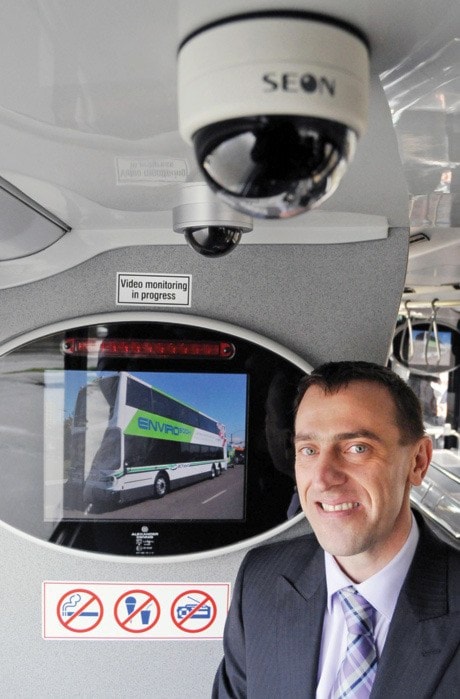The next time you catch a ride on a B.C. Transit bus – smile. You might be filmed by closed-circuit cameras.
The bus company has equipped two double-deckers and a regular bus with cameras in Greater Victoria, the B.C. testing ground for a one-year pilot program that rolled out Tuesday.
It’s hoped the high-tech capability will allow the company to deter crime onboard, reduce fraudulent injury claims and recover costs associated with traffic accidents.
The $25,000 project is coming out of transit’s provincial capital projects fund, said Joanna Linsangan, transit spokesperson.
To outfit all 1,000 buses in the provincial fleet with audio and video equipment, it would cost at least $10 million, or $10,000 per bus, not including infrastructure costs, such as additional security staff and ongoing maintenance, said Stephen Anderson, B.C. Transit’s head of corporate safety and security.
There are about 300 buses in Greater Victoria, the largest fleet in the province.
Anderson couldn’t say how much money the pilot will save in insurance rate increases caused by accidents, or recovering repair costs from drivers who sideswipe buses.
But if the technology protects passengers and transit operators from assault, and helps expedite resulting court cases, it represents “value for money,” said Anderson.
Fifty-four assaults on passengers, drivers and transit supervisors were reported from 2010 to 2011, and 16 reports were made of passengers spitting on drivers last year.
Security officials have seven days to retrieve black-box data from onboard a bus in the event of a serious complaint or assault, or when asked by ICBC, police or for Freedom of Information requests. After that, the tape is recorded over.
“It’s so important that it’s the people the system protects,” Anderson explained.
Anytime there is an incident, the driver can immediately press a button that tags a section of tape for recall later. The technology also records bus speed, breaking, signal indicators.
While Rob Holmes, president of the B.C. Civil Liberties Association, said the cameras are “one more straw on the camel’s back in privacy issues,” the head of the union representing about 560 Victoria transit drivers, believes the system is an important backup for those in the driver’s seat.
“It’s a two-edged sword and it depends on how you swing it,” said L.R. Jones, president of Canadian Auto Workers Union Local 333. “As long as they use it for security and safety and not as a tool for scrutiny for the driver, in particular."



